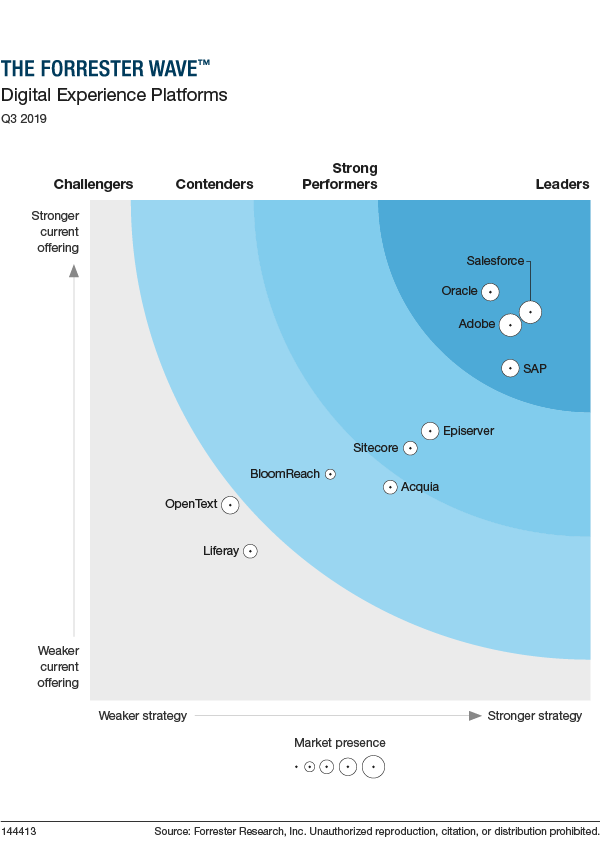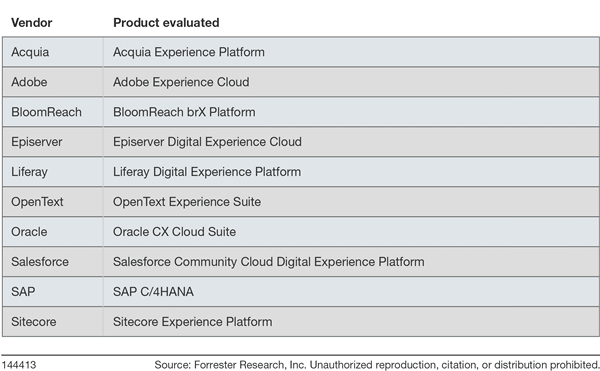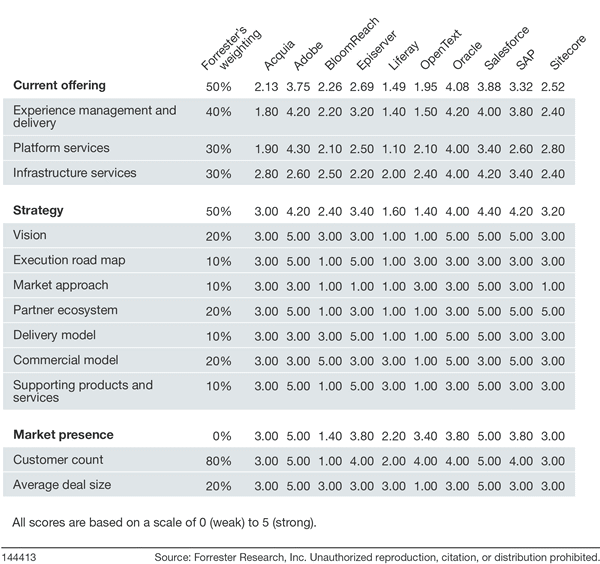CMSC Media Examines: The Forrester Wave DXP Q3 2019 — Part 2
By Ellie Somfelean
August 8, 2019
Acquia, Adobe, BloomReach, Digital Experience Platform, DXP, Episerver, Forrester, Liferay, OpenText, Oracle, Salesforce, SAP
Please click here to read our CMSC Media Examines: The Forrester Wave: DXP 2019 Q3—Part 1.
CMSC Media is proud to share our exclusive interviews with six of the leading digital experience platform (DXP) providers presented in the most recent Forrester Wave Report (Q3 2019). We undertake a two-part exploration of Forrester’s review and speak to DXP vendors ranked in the Leader, Strong Performer, and Contender groupings. Each article will feature discussions with three vendors from each of the aforementioned categories.
Click our link to receive a free copy of The Forrester Wave™: Digital Experience Platforms, Q3 2019

As discussed in our part one article review, the new Forrester Wave Report Q3 2019 arrived on July 8, 2019. The report’s authors, Mark Grannon, Ted Schadler (with Allen Bonde), Sara Sjoblom, Emma Huff, and Peter Harrison, have used a 33-criterion evaluation method to assess the ten leading digital experience platform providers. Resulting scores are tallied to gauge how each of the participating vendors “measures up and helps digital experience leaders make the right choice” when companies are in the market to purchase technology. Forrester’s infographic is divided into four main ranking positions: Leaders, Strong Performers, Contenders, and Challengers. Entries are then further positioned on the graphic based on their Current Offerings and Strategies.
The ten DXP vendors and their products featured in Forrester’s latest review are (listed alphabetically):

According to Forrester, the three key features that make a digital experience platform stand out are:
-
Experience management and delivery applications
-
Platform services that assist performance needs
-
Infrastructure services that support scaling, security, and operations
Forrester evaluated and categorized the top vendors on the market, highlighting their strengths and weaknesses. Below is a recap of the summary of the main categories and a quick overview of what and how each vendor is doing, along with Forrester’s scorecard graphic:
Leaders
Vendors in this category excel in their array of offerings, with many expanding and acquiring companies to help fill in missing gaps. Most of the leaders are robustly reliable in their B2B and B2C offerings, API management, and experience management and platform services. Some shine more than others in various aspects, but there are some commonalities in areas of weakness revolving around support, developer tools, marketing, and rich media content.
Salesforce secured its position at the top thanks to recent, strategic acquisitions that allowed them to expand their offerings. The vendor excels with its commerce capabilities in B2C and B2B thanks to having Demandware and CloudCraze on board. It also augmented its already-strong developer tool and API management department by acquiring MuleSoft. While Salesforce still needs to work on its web experience management, marketing, and rich media content, it gets points for its capabilities in dealer portals and commerce, campaigns and messaging, customer profiles, as well as an overall strong product offering.
Oracle also benefited from strategic acquisitions; increasing its product offering and strength in a wide range of categories with everything from commerce, marketing, AI/ML automation, and API management. While the vendor seems to continue to fall somewhat short in the support department—as well as their developer and practitioner talent pools—there’s hope that the new leadership will help to bring Oracle on par with their peers.
Adobe continues to stand out in experience management and platform services and gets praise from its clients for its AI and integration capabilities. The vendor has focused on improving its B2B marketing and commerce through the acquisition of Magento and Marketo and continues to have the most digital experience agency partners out of all the vendors Forrester is tracking. Adobe seems to be an ideal solution for large companies and can manage those companies’ demands, especially when it comes to Adobe’s experience management and platform services. The vendor loses points in the infrastructure services category, which includes API-management and code development, and its complex price structure can be prohibitive for some clients.
SAP ‘s new C/4HANA platform is seen as a solution to help unify and centralize the firm’s commerce, customer data, marketing, sales, and service clouds. The vendor’s strengths lie in their B2B and B2C commerce capabilities as well as their access and API management, making it the right solution for businesses with complex needs. It is noted that SAP needs to work on improving product integration, customer process automation, developer tools, and rich media content.
Strong Performers
Both vendors in this category stand out with their B2C capabilities and web experience management. Where Sitecore leads in the partner ecosystem, Episerver lags. Customers want to see better API and marketing management as well as better market automation, eventing, role-based access, and platform operations and certifications.
Episerver is a great vendor for those running on Microsoft Azure and for those that would appreciate their great B2C commerce offerings, search, and web experience management. Areas that need improvement include digital asset management, infrastructure services, and partner ecosystem and market approach.
Sitecore stands out with its solid web experience management as well as rich media and marketing content capabilities. Following the acquisition of Stylelabs and their SaaS software for rich media and marketing content creation and management, Sitecore secured a stronger standing as a DX provider with creative capabilities. On the other hand, their weak spots seem to be customer data, analytics, marketing automation, eventing, role-based access, and platform operations.
Contenders
The contenders share similar strong points in their web experience management, development tooling, and platform operations. However, clients of this category would like to see better customer data, commerce, and marketing capabilities.
Acquia continues to stand apart thanks to its content hub, web experience management, development tools, and platform operations but falls short on customer data, commerce, and AI/ML automation capabilities.
BloomReach shines thanks to its web experience management, platform operations, AI/ML-based search, and a CMS backed by great developer tools, stable APIs, and developer tools. The vendor is rapidly evolving thanks to its leadership, and hopefully, this will translate in better marketing, customer data, and analytics capabilities.
Challengers
OpenText gets praised for its marketing and rich media content and content hub despite their shortcomings in B2B and B2C commerce offerings, developer tools, and general lack of support.
Liferay’s strength might not lie in marketing, customer data, analytics or AI/ML automation, but they get credit for being the strongest in platform support, developer tools, and platform operations.

Part Two — CMSC Interviews with SAP, Sitecore, and BloomReach
CMSC Media consulted with six of the vendors to talk about the report, their services, and to see what they have in store for the upcoming future. In our part two publication, we showcase the second set of three vendors in the following exclusive interviews.
SAP
SAP Public Relations Team (SAP CEO Bill McDermott pictured)
Can we start by understanding why do companies need a digital experience platform today?
“Today’s economy is driven by experiences, and it is important to understand that Experience Management is essential to grow your business. That covers all areas of product, brand, customer, and employee experiences, and there is a risk in having a large experience gap between what companies deliver and what they think they deliver. The only way to address the experience gap is to listen, understand, and act to provide the best customer experience. We believe you have to leverage experiential data on feelings (X) and operational data on interactions and activities (O) along the entire customer journey. A powerful Digital Experience Platform (DXP) is a must to achieve this goal.”
What do you think are some of SAP's strengths when it comes to digital experience platforms?
“We see one of the reasons why SAP C/4HANA was recently recognized as a leading Digital Experience Platform provider in the fact that we have heavily invested into our portfolio to offer the most complete suite in the market, but also attain leadership positions for each of the Cloud solutions in the portfolio — Service, Commerce, Marketing, Customer Data and Sales.
Forrester’s report itself indicates that SAP is especially strong in B2C and B2B commerce, customer identity and access management, and API management versus its peers. It also states that “SAP’s strategy resonates, especially when it articulates its ‘X plus O’ vision, and the company continues to have a world-class partner network.
In the Experience Economy, businesses must deliver engaging, trusted experiences for partners, employees, and customers at every moment in the customer’s journey. SAP C/4HANA helps organizations to manage and deliver these experiences consistently, providing them with a complete digital experience platform and the right insights to turn these into personalized experiences.”
What is SAP's doing to enhance its digital experience platform further? What can we expect to see in the near future?
“We have a huge opportunity in front of us in a very competitive environment, but it is our goal to dominate in this market. Innovation in the first half of 2019 continued including the integration of Qualtrics capabilities across the entire SAP C/4HANA customer experience suite and the launch of SAP C/4HANA Foundation — our open technology layer that allows customers to deploy, manage, and extend applications in a fast and flexible way which is important for rapid, low-risk innovation.
We are also quite happy with the development of SAP Litmos, SAP’s learning management system that came with the Callidus acquisition and has delivered over one billion courses to date. SAP Litmos, CX edition solutions delivered updates designed to develop sales and customer service mastery to our mobile-friendly, agile learning platform.
On the product side, we can be very happy with our achievements in the past quarter: We launched our new native SAP Sales Cloud mobile app with built-in Conversational AI. Other developments we want to highlight include our SAP Commerce Cloud, Our Sap Service Cloud, and our Customer Data Cloud.”
Sitecore
Matt Krebsbach, Sr. Director of Product Marketing
In your opinion, what makes a digital experience platform stand out?
“Regardless of what definition you apply for a digital experience platform—and, as a still-evolving market, there are many—it’s fundamental that a DXP can deliver personalized experiences to an ever-increasing variety of devices across all points of the customer journey. That necessitates an omnichannel system of engagement, so a stand-out DXP starts with a stand-out web experience management capability.
But we also believe that a stand-out DXP places an emphasis on content as the underpinning of a digital experience. Make no mistake: customer data and omnichannel delivery are very important. But without the availability of content that can speak to the specific needs of unique customers, there is no personalization. In effect, content pays off the value of customer data and omnichannel delivery capabilities.
That is why we think Sitecore is in such an enviable position following our acquisition of Stylelabs. We now offer an end-to-end content, commerce, and personalization platform that gives our customers a one-stop-shop to address the complete content lifecycle. And that means we can help them go beyond simply optimizing the delivery of customer experiences to actually optimizing the planning and creation of effective content to nurture customers throughout their journey.”
What are some of the biggest challenges a digital experience platform is facing? What do you think are some of Sitecore's strengths when it comes to digital experience platforms?
“A DXP integrates multiple technologies to serve and control a wide span of touchpoints, which opens the door to companies amassing products that provide overlapping capabilities. That isn’t just a case of over-investment, but also unnecessary complexity. Add on top of this the reality that DXPs are either operated by or serve the needs of multiple parts of an organization, and it’s easy to see how organizational silos can hinder the ability to connect the dots between marketing assets, customer data, analytics, and more to build a clear, comprehensive picture of the customer and deliver highly personalized experiences.
This is where Sitecore sets itself apart. Sitecore Experience Platform provides a fully integrated solution that serves as a central technology platform to create, manage, optimize, and deliver omnichannel digital customer experiences. With market-leading and best-in-class capabilities for web content management, customer data management, analytics and personalization, machine learning, and campaign orchestration, we can address the core objective of a DXP from a single interface. At the same time, the ease with which we can integrate third-party applications and customer data repositories means our customers can extend Sitecore XP to fit the specific needs of their business. This is why we believe Sitecore offers both the most complete capability for the core aspects of a DXP and the market’s most flexible platform.”
What is Sitecore doing to enhance its digital experience platform further? What can we expect to see in the near future?
“From our acquisition of Stylelabs to the delivery of Sitecore Cortex AI/ML capabilities, Sitecore JavaScript Services, Experience Analytics enhancements, and the development of our next-gen UI, we’re working overtime to put more power in marketers’ hands and provide a vastly streamlined user experience. We just announced our mid-year product updates with the release of Sitecore 9.2, Content Hub 3.2, and our new Content Marketing Platform, and we’re excited to share even more new capabilities when we see thousands of our customers and partners at Sitecore Symposium in Orlando this November!”
BloomReach
Tjeerd Brenninkmeijer, EVP of EMEA
In your opinion, what makes a digital experience platform stand out?
“A Digital Experience Platform stands out when it provides agility for your business and is able to create the perfect customer journey. On the one hand, you need the technology for agility: API's, a cloud-first approach and microservices that make it easy to integrate with other tools. On the other hand, you need AI to help you manage and optimize customer journeys, not only on owned but also on third party channels. These are the needs for future-focused businesses that aim to be at the forefront of their industry. They will be looking for an agile, intelligent DXP that can generate value through AI with 1:1 personalisation and intelligent search that will be delivered with forward-looking insights into customer behaviour. Last but not least, a DXP should be enterprise-ready in terms of scalability, data security, integrations, and personalization (both anonymous & logged in). In short: an outstanding DXP helps you create and manage the experience, understand your customers, personalize the experience in context, and deliver value to the business.”
What is BloomReach doing to enhance its digital experience platform further? What can we expect to see in the near future?
“BloomReach is currently doubling down on its API's with a Headless Experience API, Headless content API, Intelligent Search API, Category API, Recommendations API, and Assets API. We're also doubling down on productized integrations and accelerators with other software vendors which are available in the BloomReach Marketplace. Not only with commerce platform providers like Salesforce, SAP, BigCommerce, ElasticPath, and commercetools, but also with providers of other solutions like DAM, Marketing Automation, ERP, CRM, DMS, PIM, translation services, etc. Our primary focus is and will always be on our intelligence: optimizing algorithms, unifying more data (including third party data) and providing better insights and tooling/UI’s for the business to A/B test, monitor and optimise.”
What do you think are some of BloomReach’s strengths when it comes to digital experience platforms?
“Digital experience platforms [DXP] are still a fairly new category that hasn't been clearly defined. However, we're seeing a trend that the definition is shifting from the DXP as a monolithic suite containing everything from CMS and portal to Marketing Automation, ERP and Ecommerce towards a DXP as an agile, headless and cloud-first solution that easily integrates with other best of need software offerings and allows enterprises to innovate faster. BloomReach is at the forefront of this headless movement and is the only vendor to offer value generation through AI as a core part of its DXP solution. This means we are excellently positioned to support enterprises in their movement towards the next chapter of digital business.”
What are some of the biggest challenges a digital experience platform is facing?
“I would say that the biggest challenge the industry is facing at the moment is the confusion in the market about what a DXP exactly is. This makes it hard for enterprises to assess which capabilities they are looking for in a DXP. It is our job as software vendors, together with analyst firms and our partner ecosystem, to educate people on the future needs for digital business and show them how they can win in tomorrow's market.”
Ending Thoughts
While it’s interesting to see how each vendor is addressing growth and trying to keep pace in the digital experience platform race, it seems the ‘leaders’ share the common strategy of acquiring other companies to help fill in their offering gaps and allow them to broaden the range of services offered. Is this the way to shoot to the top of the Forrester chart?
Did you miss CMSC Media’s part one review of the 2019 Forrester DXP report? You can find it here:
CMSC Media Examines: Forrester Wave DXP 2019 Q3—Part 1

Ellie Somfelean
Ellie is a Reporter and Content Marketer with CMSC Media. She is passionate about social media and digital marketing. She has a vast experience with content creation, influencer marketing and brand promotion.